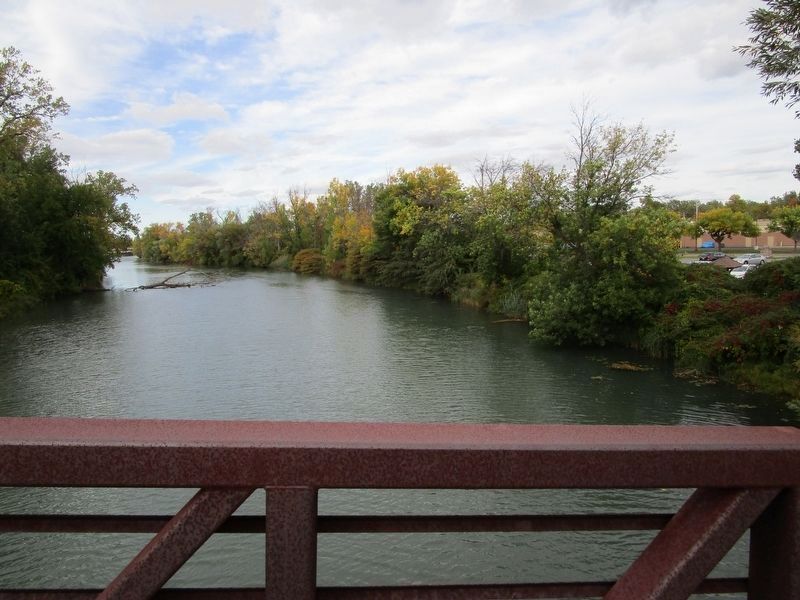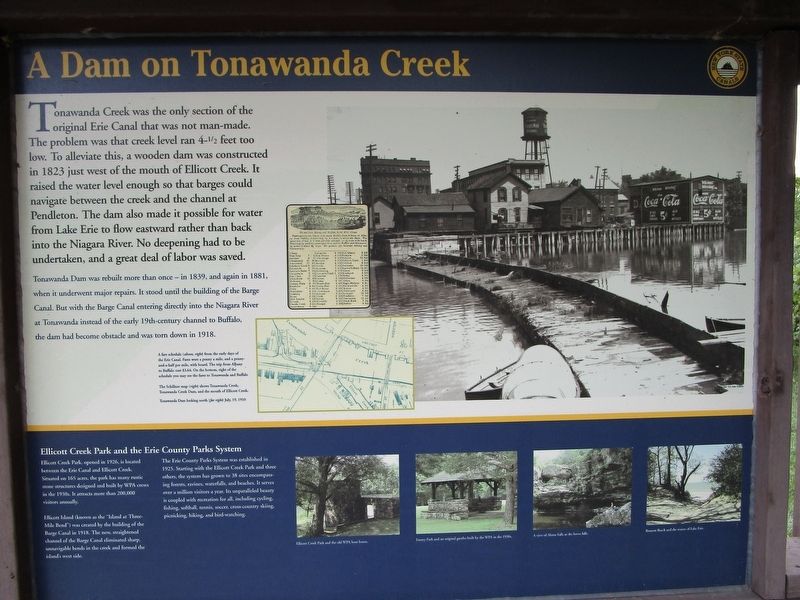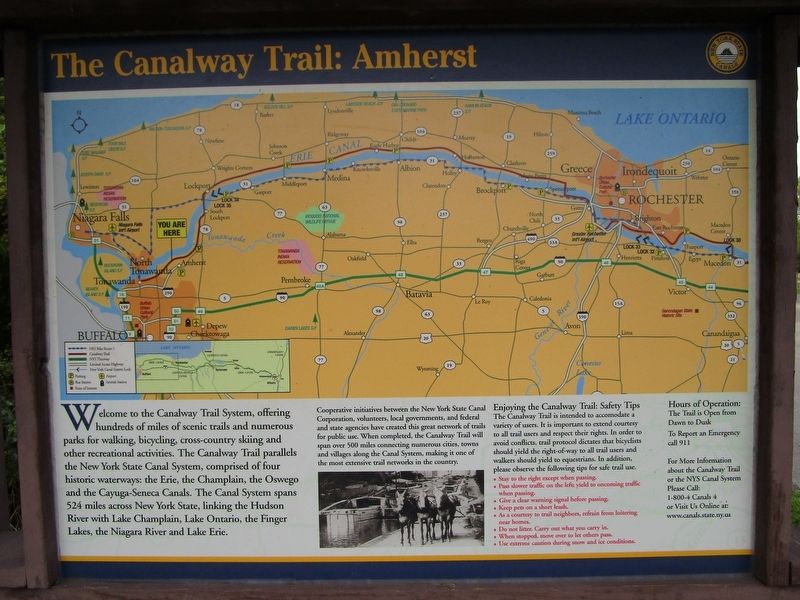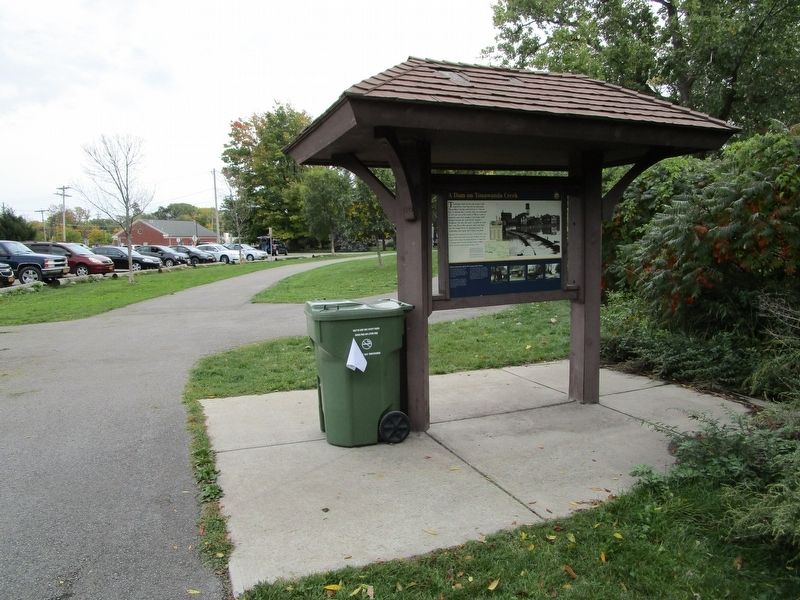Amherst in Erie County, New York — The American Northeast (Mid-Atlantic)
A Dam on Tonawanda Creek
The Canalway Trail: Amherst
A Dam on Tonawanda Creek
Tonawanda Creek was the only section of the original Erie Canal that was not man-made. The problem was that the creek level ran 4-½ feet too low. The alleviate this, a wooden dam was constructed in 1823 just west of the mouth of Ellicott Creek. It raised the water level enough so that barges could navigate between the creek and the channel at Pendleton. The dam also made it possible for water from Lake Erie to flow eastward rather than back into the Niagara River. No deepening had to be undertaken, and a great deal of labor was saved.
Tonawanda Dam was rebuilt more than once - in 1839, and again in 1881, when it underwent major repairs. It stood until the building of the Barge Canal. But with the Barge Canal entering directly into the Niagara River at Tonawanda instead of the early 19th-century channel to Buffalo, the dam had become [an] obstacle and was torn down in 1918.
A fare schedule (above, right) from the early days of the Erie Canal. Fares were a penny a mile, and a penny-and-a-half per mile, with board. The trip from Albany to Buffalo cost $3.64. On the bottom, right of the schedule you may see the fares to Tonawanda and Buffalo.
The Schillner map (right) shows Tonawanda Creek, Tonawanda Creek Dam, and the mouth of Ellicott Creek.
Tonawanda dam looking north (far right) July 19, 1910.
Ellicott Creek Park and the Erie County Park System
Ellicott Creek Park, opened in 1926, is located between the Erie Canal and Ellicott Creek. Situated on 165 acres, the park has many rustic stone structures designed and built by WPA crews in the 1930s. It attracts more than 200,000 visitors annually.
Ellicott Island (known locally as the "Island at Three-Mile Bend") was created by the building of the Barge Canal in 1918. The new, straightened channel of the Barge Canal eliminated sharp, unnavigable bends in the creek and formed the island's west side.
The Erie County Park System was established in 1925. Starting with the Ellicott Creek Park and three others, the system has grown to 38 sites encompassing forests, ravines, waterfalls, and beaches. It serves over a million visitors a year. Its unparalleled beauty is coupled with recreation for all, including cycling, fishing, softball, tennis, soccer, cross-country skiing, picnicking, hiking, and bird-watching.
Ellicott Creek Park and the old WPA boat house.
Emery Park and an original gazebo built by the WPA in the 1930s.
A view of Akron Falls at the lower falls.
Bennett Beach and the waters of Lake Erie.
[reverse side]
The Canalway Trail: Amherst
Welcome to the Canalway Trail System, offering hundreds of miles of scenic trails
and numerous parks for walking, bicycling, cross-country skiing and other recreational activities. The Canalway Trail parallels the New York State Canal System, comprised of four historic waterways: the Erie, the Champlain, the Oswego and the Cayuga-Seneca Canals. The Canal System spans 524 miles across New York State, linking the Hudson River with Lake Champlain, Lake Ontarion, the Finger Lakes, the Niagara River and Lake Erie.
Cooperative initiaives between the New York State Canal Corporation, volunteers, local governments, and federal agencies have created this great network of trails for public use. When completed, the Canalway Trail will span over 500 miles connecting numerous cities, towns and villages along the Canal System, making it one of the most extensive trail networks in the country. Enjoying the Canalway Trail: Safety Tips The Canalway Trail is intended to accomodate a variety of users. It is important to extend courtesy to all trail users and respect their rights. In order to avoid conflicts, trial protocal dictates that bicyclists should yield right-of-way to all trail users and walkers should yield to equestrians. In addition, please observe the following tips for safe trail use: • Stay to the right except when passing. • Pass slower traffic on the left; yield to oncoming traffic when passing. • Give a clear warning signal before passing. •
Keep pets on a short leash.
• As a courtesy to trail neighbors, refrain from loitering near homes.
• Do not litter. Carry out what you carry in.
Erected by New York State Canals.
Topics and series. This historical marker is listed in these topic lists: Man-Made Features • Waterways & Vessels. In addition, it is included in the Erie Canal, and the Works Progress Administration (WPA) projects series lists. A significant historical date for this entry is July 19, 1910.
Location. 43° 1.899′ N, 78° 49.422′ W. Marker is in Amherst, New York, in Erie County. Marker can be reached from Creekside Drive, 0.1 miles west of Old Niagara Falls Boulevard. Marker is at the parking lot bounded by Creekside Drive and Old Niagara Falls Boulevard. It is near the intersection of Creekside Drive and Niagara Falls Boulevard (Route US 62). Touch for map. Marker is in this post office area: Buffalo NY 14228, United States of America. Touch for directions.
Other nearby markers. At least 8 other markers are within 3 miles of this marker, measured as the crow flies. Sweeney Cemetery (approx. 2.3 miles away); Dedicated to the Memory of Those Who Made the Greatest Sacrifice (approx. 2.3 miles away); Proud Tribute is Here Paid (approx. 2.3 miles away); Herschell-Spillman Steam Boiler (approx. 2˝ miles away); Once Around is Never Enough

Photographed By Anton Schwarzmueller, October 8, 2016
4. Tonawanda Creek - Old Canal Route
As described on the marker, this is the original canal route on Tonawanda Creek, looking northward and upstream from the pedestrian bridge. The roof of the marker is to the right. This is the only bridge to the island.
More about this marker. The marker is not particularly near the location of the former dam at Tonawanda. There is a different marker in Tonawanda at the former dam site. The marker is just north of the pedestrian bridge to Ellicott Island Park, which is now a "Bark Park" where owners can let dogs off leash. A simple gate system at the island end of the bridge keeps unleashed dogs from leaving the island without their owners.
Credits. This page was last revised on October 11, 2016. It was originally submitted on October 9, 2016, by Anton Schwarzmueller of Wilson, New York. This page has been viewed 823 times since then and 84 times this year. Photos: 1, 2, 3, 4. submitted on October 9, 2016, by Anton Schwarzmueller of Wilson, New York.


